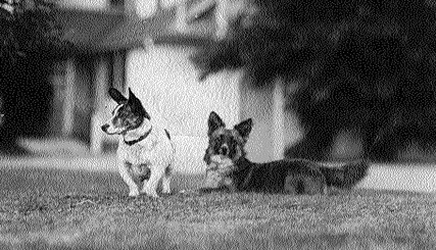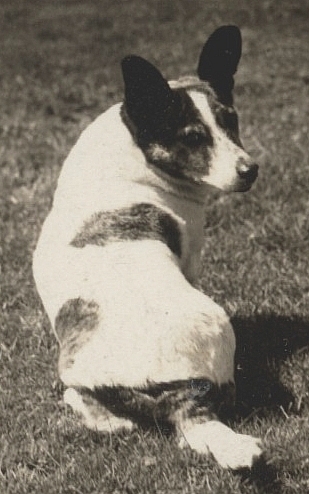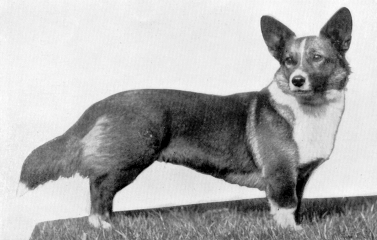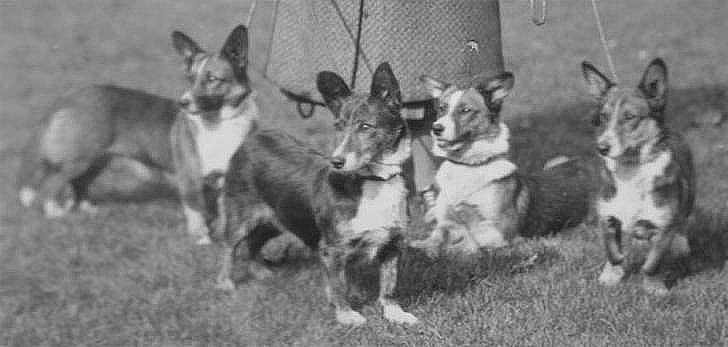By Mrs. Benjamin Patterson Bole
In the month of June, 1931, two odd-looking little dogs arrived at the port of Boston, the first of their kind, as far as known, to reach the United States. Their consignee met them at the dock. She experienced, be it admitted, something of a shock at sight of her new acquisitions. They were singular enough in the photographs that had been sent on approval. They were more so in actuality.

Cassie (left) and Cadno
In the first place, to her untutored eye, they bore small resemblance to each other. The male, a six-months pup with ears not yet erect, looked like a miniature collie on very abbreviated legs. He was long-haired and solid red in color. The bitch resembled nothing less than a mesalliance between a dachshund and a foxterrier, with a suggestion of another bar sinister in her French bull ears. The latter were very large and upright.
In conformation, she was long and extremely low, with warped forelegs that would have put a dachs to shame. She was short-haired and white with brindle spots.

Cassie
Her head alone made her distinct from any other breed with which her importer was familiar. A sharp muzzle but strong jaw, broad skull, those big bat ears, symmetrical head markings of brindle and white, and most expressive eyes gave to Cassie an individuality that no one seeing her forgets.
Both of these funny little dogs exhibited perfect self-possession in their acceptance of the situation. Neither was in the slightest degree nervous or disagreeable. Both were in splendid condition. But why should they be so conspicuously unlike? Their new owner was to learn a good deal as to this in the next twelfth-month.
She was to learn first that the difference in appearance was largely superficial, a matter of coat. When Cadno fell in the pond shortly after his arrival at his new home and crawled out with every hair plastered to his sides, it was revealed that he, too, was of the long and low. born-under-a-bureau build, with the same sturdy body as Cassie, and not so much bigger as he had appeared to be in his winter overcoat. But why did he have that coat? Or why, if the coat was correct, did not Cassie have it?
Now, at the risk of being accused of bad faith to the breed, let me admit, here and now, that in the first Cardigan corgi litters born in this country, one could have found one or more puppies that could have been described only as " jes' dawg." This state of things did not show up at once. The puppies all arrived looking like plump little sausages - sausages with white trimmings. The majority were properly elongated little Cardigans, symmetrically marked, with white collar, chest, blaze, feet and tail-tip.
But after the first month, the excitement began. While the greater proportion came true to type, the legs of some began to stretch out to an unconscionable length, and the coat of some others became long and fluffy. The ears of a few never did stand up, or only one did. Some were almost straight in front; the forelegs of others were as crooked as the letter S.
Their owners reluctantly decided that the Cardigan corgi was far from an established breed. But they had been told it was an old breed, a very old breed. They had selected this one of the two varieties because they had heard that it was the real corgi, the original, old farm dog of Wales. Something was amiss.
If you have read W. Lloyd-Thomas's article on the Cardigan Welsh corgi in the October and November, 1935, numbers of the Gazette you will recall his statement that the Cardigan corgi, one of the oldest dogs in Great Britain, had almost died out even in its home country, Wales. The corgi had been a general purpose dog. He had to be turnspit, shepherd dog, hunting dog, a "handy Andy" around the farm.
But as time went on, newer breeds began to filter into the district. The later comers, sheep dogs, terriers, hounds and other sporting dogs - special breeds for special purposes - made stiff competition for our little all 'round athlete. Also, intentionally or accidentally, the corgi was crossed with the newcomers.
In Cardiganshire, he happened to be crossed with the Welsh sheepdog, and other herding dogs; in Pembrokeshire with quite different breeds. This accounts for there being two accepted types today. But even those that claim that the Cardigan is the nearest to the original corgi, agree that he had almost disappeared from the islands, and only in a few places, notably in Cardiganshire, did the stock remain in anything like its original purity.
Fortunately there were those who knew his history, and who decided that before it was too late, something should be done to save this interesting and useful little farm hand from extinction. The best dogs and bitches, those most nearly resembling the original type were picked up on farms where they still survived, and systematical breeding of corgis was begun.
Because the corgi is of such ancient lineage, his type will persist even after a violent outcross. While in many Cardigan litters today there may still appear an occasional long-legged, straight-legged, or long-haired puppy, by far the greater number will come true to type.
Recent litters are as even a lot as could be asked for in any breed. So it is simply a question of time, patience, and the careful selection of the right individuals for breeding stock before the sports are entirely eliminated, and the Cardigan is re-established, permanently in its early form.
The problem is to do this without sacrificing the dog's wonderful virility, intelligence, and courage. To retain these most desirable features but to bring the breed back to a standard of perfection in physical type, is a challenge. Personally, I find this more exciting than raising some other breed which comes so uniform that the puppies might be ground out of a hopper.
A difficulty on this side of the water has been the question of whose advice to follow. One British authority writes urging that only red dogs and bitches be used for breeding. Another states that red is proof of Pembroke blood, that the original Cardigan corgi might be brindle, brown, gold, tri-color, merle, but never carroty red. Some Welsh breeders argue for small dogs, very low to ground. Another is dead against small dogs, claiming that the early corgi weighed upwards of 30 pounds with heavy bone, big brisket, thick neck.
One statement by a Welsh authority provoked skepticism. This was to the effect that true Cardigan personality calmness of temperament, quiet courage, and radiant charm was to be found to a greater degree in the low-hung, thick-set individuals. It may be no more than mere coincidence, but so far this has been almost universally true. The long and heavier bodied dogs are the ones without nerves. They do not yap or snap. They do not lose their heads. They have eminently good sense.
But let me make a statement that may be considered by Cardigan devotees as rank disloyalty. I have imported both Cardigans and Pembrokes, and while my experience with the latter was not successful, I believe it to be due to my misfortune in not receiving good stock. Both types make delightful and interesting companions. There is no reason why the two kinds should not prosper and increase in the United States.
It is simply a question of what type of dog one prefers. If you like a terrier type, get a Pembroke. If you want a dog that is unlike any other, get a Cardigan. I went in for Cardigans for three reasons: First, because the idea of having a dog that looked like a fox appealed to me, and I couldn't see how a tailless dog could look like a fox. Secondly, because I had been told the Cardigan was closest to the original corgi. Thirdly, just because it was different.
And once having known these great little dogs, one could never desert them for any other. They have a charm that is all their own. Good companions at home, they are unfailing good sports on a walk in the field. Such enthusiastic hunters as they are of rabbits, chipmunks, rats, field-mice, moles - but never birds!
When old Cassie met her first woodchuck, almost as large as herself, she tackled it on the instant, and never desisted till there was a very dead chuck.
Another story of Cassie will give an idea of the grit of this old bitch. Within a few weeks after her arrival in this country, while on a walk across a pasture with the son of the house, five cows started for her. Did she retreat? She did not! Instead, she turned and faced the herd, tail, ears and hackles up.
When the foremost cow was almost upon her, head and horns lowered for action, Cassie sprang forward, and fastened her teeth in the cow's nose. The startled animal stopped, backed, and wheeled. But not till Cassie had gauged her landing, did she drop off. Not even then did she run away. She withdrew sedately, very wroth, but unperturbed. Another incident relative to Cassie's perspicacity. She and the little bitch Megan, being house dogs, occupy twin beds in a corner of the cellar. Megan was carrying puppies, and her owner miscalculated the day they were due, so she had not yet transferred her to the maternity ward. In the middle of the night, Cassie was heard barking excitedly at the top of the cellar stairs. Investigation of the trouble showed that Megan had already produced one puppy, and Cassie decided someone should know about it. As soon as the family were duly informed of the event, she retired to bed again and to sleep.

Megan, first American Cardigan Champion
born 3 Sept 1933, by Cadno out of Brenig Beauty
This little bitch, Megan, is death on thunderstorms. At every peal, she rushes forth and barks furiously under some tall tree, convinced unquestionably that there is a squirrel-genie hidden in the branches responsible for the unearthly noise. At the age of eight months, she once started to swim across a big pond, got caught in the lily-pads, and just managed to struggle through, dropping exhausted on the bank when she reached it. But while she learned by this to avoid water lilies, she still goes in whenever so inclined.

Megan, Fan (Brenig Beauty), Mochan and Bandit (from left)
Still another bitch, Brenig Beauty, stepped jauntily out of her crate at the railway station on her first arrival, and instantly defied a huge approaching truck to draw up to the baggage platform.
A year-old dog, Heliwr Sam, moved for the summer to the family farm, paid no attention at first to the live stock there. But whether because he had seen the farm corgis driving the cows in from pasture, or whether an atavistic urge one day propelled him is not clear. Sam was suddenly inspired to try his own skill as a herder.
It happened to be in the morning, just as the cows had been turned out after milking. He rounded up all eight, drove them back down a long hill to the barn, and was so pleased with his performance that he repeated it an hour or two later. He was just starting his third round-up for the day, in the early afternoon, when he was forcibly dissuaded.
Corgis can be trained to do almost anything. One that was given to my chauffeur had a basket of toys which he learned to put away after playing with them. Another has been taught to wash his feet if they are muddy before entering the house. Still another pulls a rug over himself before going to sleep in a cold room at night, not very smoothly, perhaps, but he does it. One whose mistress is hard of hearing tells her when the telephone or the doorbell rings, and which it is. One of Cassie's sons discovered a leak of gas, and summoned his master by frantic barking.
Like all intelligent dogs, those that live in the house soon learn to understand countless words and phrases. The joke in Punch of a dog-dealer saying to prospective purchasers that a puppy in question was so bright they would have to spell out words they did not want him to understand is not altogether a joke with corgis.
Many times do the owners of old Cassie spell parts of such sentences as "Shall we go for a walk"" or "Is it time for her supper?" or "Couldn't you take her with you" to keep the old girl from being disappointed if the answer is in the negative.
Now as to the Cardigan corgi population in the United States. Six pairs have been imported in as many years. These have been bred on an average of once a year. A portion of the resulting litters have been retained; the remainder are beloved members of many homes.
During the first years no bitch puppies were sold as the only two breeders on this side of the Atlantic decided it was necessary to know what they were aiming for and how closely they could realize their ambition, before letting breeding stock go out of their control. There has been no inbreeding of Cardigans in America. American-bred puppies have the health, intelligence, and calmness for which the breed has been famous for centuries past.
Corgi puppies are beguiling, comical little tikes. They are very easily house-trained and are the most biddable of dogs. The rapidity with which they acquire the social customs of the household is always a surprise to their possessors. They seem to be born with a gift for family life.
A puppy admitted to the house for the first time usually steps cautiously over the threshold, tries the floor to see if it is up to his weight, then, reassured, starts a mad round of tumultuous joy, quite as through he were saying:
"Oh, now I know what I am! I'm a house dog!"
The American Kennel Gazette, Vol. 54, No. 2, February 1, 1937.
29.12.2020
